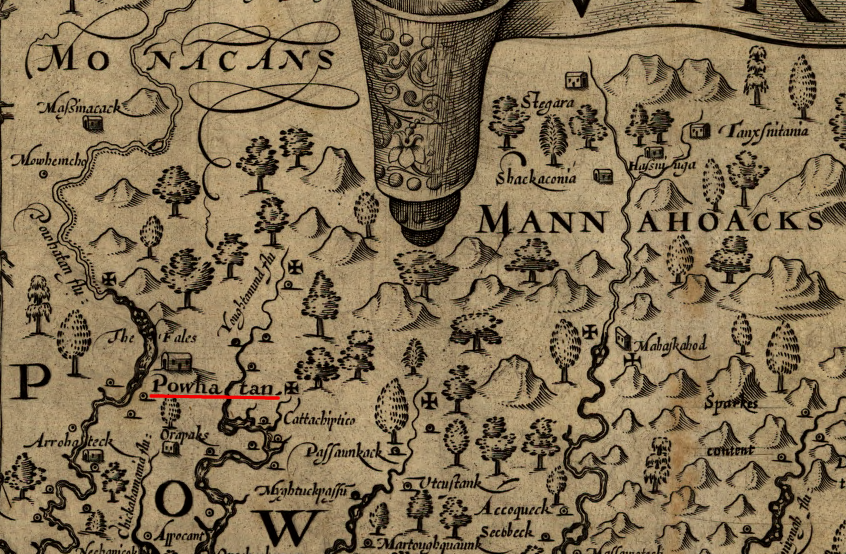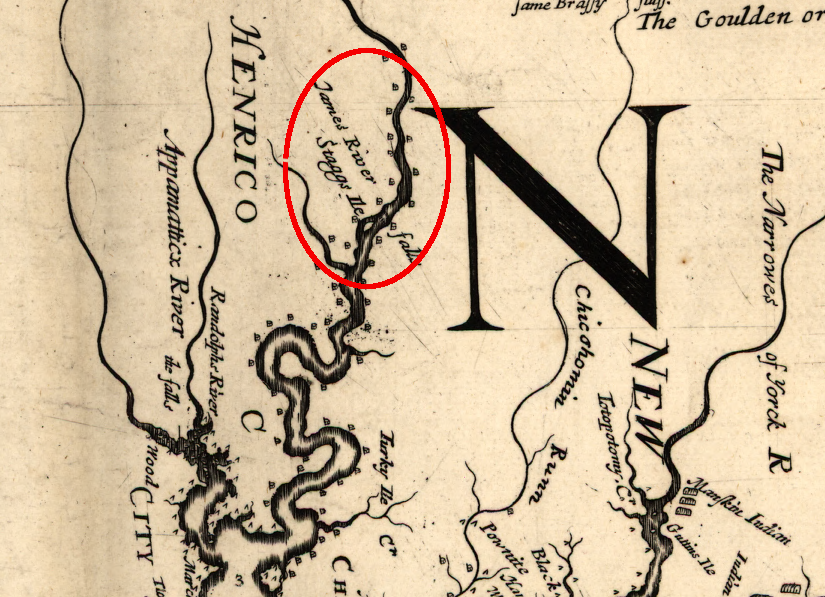
Powhatan inherited authority over six tribes when he was living at the town where he was born, also known as Powhatan
Source: Library of Congress, Virginia (John Smith, 1624)

Powhatan inherited authority over six tribes when he was living at the town where he was born, also known as Powhatan
Source: Library of Congress, Virginia (John Smith, 1624)
Powhatan inherited power over six tribes when his uncle died sometime before 1600. At the time, he was living just downstream from the Fall Line on what the English later called the James River. Powhatan then expanded his authority over the territory of Tsenacommacah to include more than 30 tribes.
Before the English arrived, he moved his capital from the James River east to Werowocomoco on what the English later called the York River, closer to the center of Tsenacommacah. His old town on the James River became known as Tanx (Little) Powhatan.
Werowocomoco had been a major spiritual center for two centuries. Moving east to that location gave the paramount chief additional authority and power.
Soon after reaching Virginia in 1607, Captain Christopher Newport sailed up what the Native Americans called Powhatan's River and what the English called the James River. Before he reached the rapids which blocked further exploration by ship at the Fall Line, he spotted a town at what is thought to be modern Tree Hill Farm, southeast of Richmond.1.
That town was ruled by Parahunt. He was a weroance subordinate to Powhatan, and perhaps his son.
Initially the English confused the "Powhatan" name and thought they had met the paramount chief. Parahunt accompanied Captain Newport upstream to the site where the English planted a cross. Parahunt convinced Newport not to go further, trying to limit the potential for the English to trade with (or ally with) the rival Monacans living west of the Fall Line.2
In 1609, John Smith dispersed the colonists and arranged for some to live at the Fall Line on the James River. The Third Supply ships had arrived in late summer with too many new colonists and too little food. By spreading out from Jamestown, Smith hoped the colonists could forage and trade for food more successfully. He also sought to disperse rival leaders who sought to replace Smith as president of the council, but lacked official authority since the Sea Venture with the new deputy governor had not arrived.
Francis West took a group upstream to the falls. He settled on the flood plain, and the efforts to trade/steal food from Parahunt led to conflict. John Smith arrived and negotiated a settlement, buying the town site in the package. That separated the Native Americans and the colonists further, and enabled the English to live at a higher elevation with less risk of flood.
As soon as Smith sailed back downstream, the colonists chose to return to their old site on the flood plain. Smith returned again and arranged for a peace, but it was only temporary. On his journey back to Jamestown, his bag of gunpowder exploded and he was too seriously wounded to deal with Francis West's intransigence any longer.
Smith sailed home to England, and Francis West and his men soon returned back to Jamestown. Parahunt was left in control of the site where Powhatan was born.3

by 1670, the former town of Powhatan was no longer named on a map
Source: Library of Congress, Virginia and Maryland as it is planted and inhabited this present year 1670 (by Augustine Herrman)